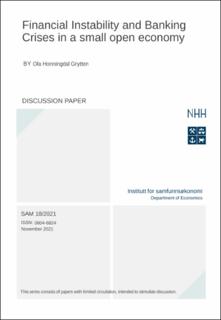Financial Instability and Banking Crises in a small open economy
Working paper

View/
Date
2021-11Metadata
Show full item recordCollections
- Discussion papers (SAM) [657]
Abstract
The present paper seeks to investigate the importance of financial instability during four banking crises, with focus on the small open economy of Norway. The crises elaborated on are the Post First world war crisis of the early 1920s, the mid 1920s Monetary crisis, the Great Depression of the 1930s and the Scandinavian banking crisis of 1987-1993.
The paper firstly offers a brief description of the financial instability hypothesis as applied by Minsky, Kindleberger, and in a new explicit dynamic financial crisis model. Financial instability creation basically happens in times of overheating, overspending and over lending, i.e., during significant booms, and have devastating effects after markets have turned into a state of crises.
Thereafter, the paper tests the validity of the financial instability hypothesis by using a quantitative structural time series model. The test reveals upheaval of financial and macroeconomic indicators prior to the crises, making the economy overheat and create asset bubbles due to huge growth in debt. These conditions caused the following banking crises.
Finally, the four crises are discussed qualitatively. The conclusion is that significant increase in money supply and debt caused overheating, asset bubbles and finally financial and banking crises which spread to the real economy.